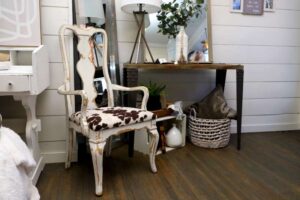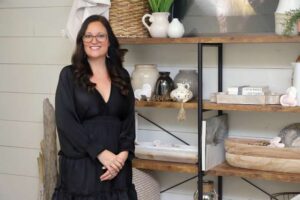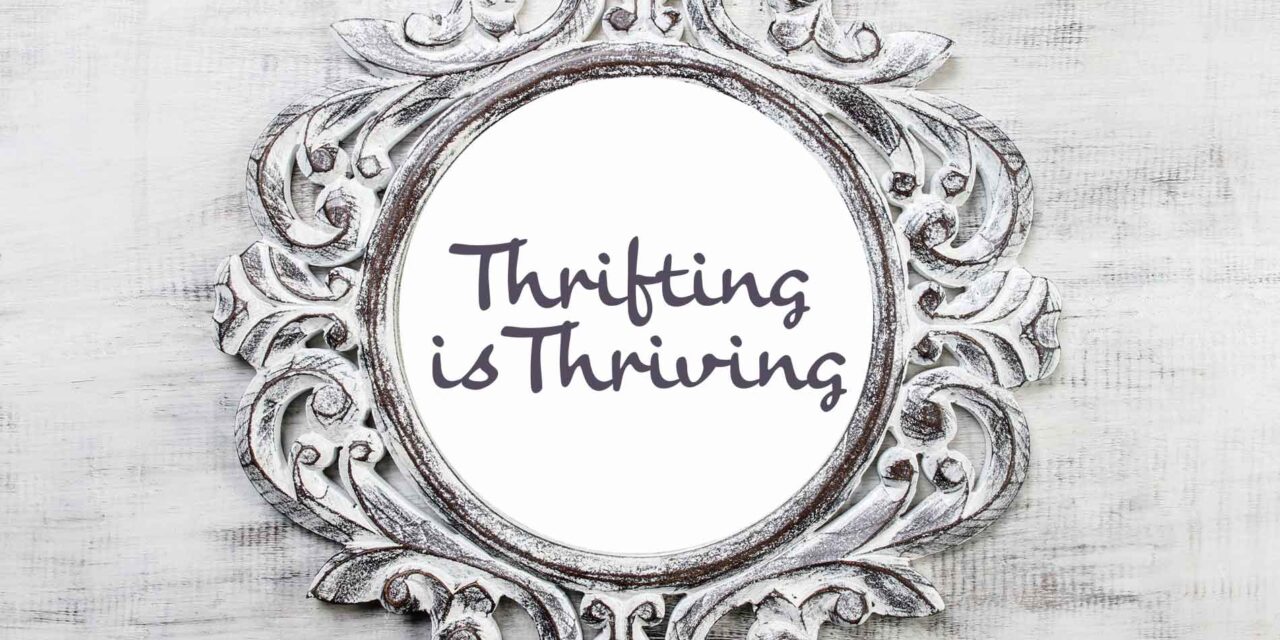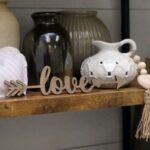by Amanda Milewski – photography by Nikola Tzenov
Popularity is surging for Second-hand clothing and upcycled furniture from local shops & online retail sales
Remember hand-me-downs? The oldest child got the new clothes, and siblings two and three eventually inherited them in turn? The scourge of childhood for some. But it certainly made sense for cost-conscious parents, particularly if they had invested in quality clothing that could last through (ahem) the rough-and-tumble of three boys.
Fast-forward a number of years, and now those same kids, like many of their contemporaries, are paying for hand-me-downs at Goodwill and other thrift stores, and through online resale sites.

Kelly + Co. carries upcycled furniture and accessories refinished by Kelly Wickesser and local vendors.
The current trend in buying secondhand clothing is primarily being driven by Gen Z’ers, spurred along by influencers on social media. But plenty of millennials and even baby boomers know a bargain when they see one and are doing their share to make thrift store shopping a billion-dollar industry.
Influencers aside, thrift store shopping not only offers cost savings, it also does its part for the planet. Thrifting and “upcycling” save items from the landfill. According to the Environmental Protection Agency, 17 million tons of textile waste ended up in landfills in 2018. Textiles can take more than 200 years to decompose.
Of course, there are some who would turn their noses up at buying anything used, but it has been de rigueur in many circles for decades: think of fancy (and pricey!) antiques, estate jewelry, cars, firearms, mansions, and houses (duh).
The lingo and the locales
Not-for-profit thrift stores like Goodwill sell secondhand items for a flat fee. At consignment stores, a percentage of the sale price goes back to the owner. Some consignment stores have a declining sale price, depending on how long the item has been in the store. For instance, after two weeks on the rack, the item might be marked down by 10 percent.
There are numerous online resale sites, too — ThredUp, Poshmark, Tradesy, Mercari, and of course eBay. There is also Marketplace on Facebook as well as a number of locally administered resale Facebook pages and groups and online sites. Some major retail brands like Patagonia, REI and Levi’s operate second-hand sale sites of their own goods.
According to the National Association of Resale Professionals, there are 25,000 resale, consignment and not-for-profit resale shops in the United States. And it seems like there are just as many terms for secondhand goods: used, thrifted, vintage, antique, pre-owned, and upcycled, to name a few. And if you shop online, there are a number of different acronyms to describe an item: EUC, NWOT, NWT, NWOB.
Most of these terms mean the same thing: something you can buy that was previously used or worn by someone else. Antique usually means something 100 years or older. Vintage is used for anything from 20 to 99 years. My husband’s family’s baptismal gown, which was worn by our children’s great-grandmother, was an antique. My clothes from the ’80s are vintage.
(For the record, EUC is “excellent used condition”; NWOT is “new without tags”; NWT is “new with tags”; and NWOB is “new without box”. Which brings up an important point. Items being thrifted don’t have to be used. Some items being resold are new items that were never worn. Maybe they couldn’t be returned or were a gift that didn’t fit or wasn’t liked.
And also for the record, upcycled, which can be done to virtually anything — clothing, furniture, Airstream trailers — means to transform an old item into something new.
Upcycling spoke to her heart
For Kelly Wickesser, decorating is a lifelong interest. A native of Carroll County and previously a stay-at-home mom, she fell in love with a storefront on Main Street in Westminster, and when it became available she saw it as a pivotal moment in her life.

Kelly Wickesser, Kelly + Co., looks for quality, real wood construction to upcycle for her customers.
“I wanted to do something else you know, something to show my kids that I’m not just a mom. And I have loved decorating my whole life, and my mom had Stage Four cancer (we were going on 14 years of Stage Four cancer) and so I knew that this was the moment that I had to do it,” she recalled.
Do it she did. She opened Kelly + Co. at 185 E. Main St. on Feb. 1, 2020, amid the emerging pandemic and her mom’s battle with cancer — which to someone with a business background might not seem the most opportune moment to start a business.
Her store is about half upcycled furniture, which she refinishes herself, and the other half is stock from vendors, some of which is upcycled and handmade.
Despite having to close most in-person shopping due to COVID, Wickesser thinks that the pandemic actually helped her business, at least a little bit. “COVID kept people in their homes more and ‘home’ means much more to people now than it ever did. People want nice, well-made things in their homes. They want furniture that is solid wood, and they don’t want to wait for six months to a year to get it because COVID also changed production and delivery times.”
Most of the furniture in today’s retail market is not real wood, said Wickesser. It’s compressed wood composite with a picture of wood grain glued on the outside. When she looks for furniture to upcycle, real wood construction and dovetail joints on the drawers are two of the earmarks of a quality piece. In addition to looking for the furniture herself, many people bring furniture to her.
“One of my customers recently came to me and said, ‘I have a dresser that was my grandfather’s when he was a child and I don’t want it anymore, but would you be interested in buying it?’ I’m like, well yes, absolutely, you said ‘grandfather,’ which means old, and it’s got to be a solid piece of furniture. The fact that they asked me about this piece of furniture, to me, that’s amazing. They’re asking me if I would like an heirloom piece of furniture that’s been in their family for so many years. … It’s an honor that they think of me first.”
Kelly + Co. is open from Wednesday through Saturday, and business is booming. Sales have increased 146 percent since Wickesser opened her doors.
On Mondays and Tuesdays, she looks for and works on upcycled furniture, or she makes things like wreaths for the store. Merchandise moves so quickly that she always has to be at least a step ahead, a testament to the store’s popularity and the need it is meeting for its customers.
Wickesser’s mom, who was perhaps her and Kelly + Co.’s largest champion, passed away in June 2020. In dealing with her grief on top of worries about the pandemic, Wickesser recalled, “This little store saved me, and it also brought a lot of fun and joy for [many] people during such a scary time.”
Savvy shoppers take note
In addition to her recommendation of visiting thrift stores on a regular basis, savvy shopper Robin Stevenson also offers the following tips.
- Get recommendations for places that sell nice things. You also need a lot of patience. The racks are usually jam-packed and it takes a while to go through everything. Make sure to inspect everything carefully.
- Some large thrift stores accept almost everything they receive so you have to spend extra time and effort searching through some of their lower-quality items to find name-brand, high-quality clothing.
- Avoid shopping on weekends or at the beginning of the week when it is crowded and the clothing is picked through. Midweek seems to be a better time. Plus, most people bring in their hauls during the weekends, so they are usually unpacked and ready for sale by midweek.
- Consider thrift stores for things other than clothes. Stevenson often bought children’s books at thrift stores, especially when her family did a Christmas countdown with 24 days of books, opening a new-to-them book each day.
Eldersburg resident Robin Stevenson began thrift store shopping about 12 years ago when her daughter was in preschool.
“A friend of mine on Facebook ‘liked’ some posts made by a [local] thrift store and I was intrigued! I started with two [local] spots and through the years have found some other favorites,” she said.
Parents often find thrift store shopping advantageous since children outgrow clothing faster than they can wear it out. “When I realized that my kids were outgrowing their clothes in six months to a year, and I could dress them in name-brand ‘expensive’ clothing for a fraction of the cost and then either donate or resell later, it was a no-brainer,” Stevenson said.
“I have found that elementary-age girls’ clothing seems to be ‘better’ to buy due to the condition of the items,” she noted. “Little girls stereotypically tend to be neater, and since they outgrow the clothing so quickly, often the clothes appear even newer. Also, ‘dressier’ boys’ or men’s clothing tends to be nicer due to the items often being worn only once or twice and then outgrown or thrifted.”
Because the stock changes frequently, thrift store shoppers recommend buying an item you are interested in right away; when you return the item may be gone. For that reason, too, visiting thrift stores regularly is a good idea. What they don’t have one week, they might have the next.
Stevenson thrift-shopped every other week when her children were in elementary and preschool. Now she goes once every few months and shops for the entire family.
She looks for name brand or designer items that are in mint condition. “If they have tags on them, even better.” Although she has shopped for specific items — “a boy’s blue blazer or a Ravens jersey or a specific style of dress for my daughter — these days we just go for fun and with a teenager who has very specific taste in brand names and styles. We never know if we will get lucky or not.”
When outfitting a teenage daughter, the cost savings can be “off the charts,” Stevenson confirmed. So thrift stores can be a great way to ease the pain. “A ‘like new’ Vineyard Vines pullover that costs upwards of $80 new might be $19.99 at the thrift store, and you can’t even tell that it was pre-owned,” she said.
 But there are some items Stevenson won’t purchase at thrift stores, no matter how good the deal is. “Absolutely no bathing suits, bras, pajamas, or socks — and shoes have to be brand-new or never worn.” And Stevenson washes the clothing as soon as she takes it out of the bag. “I don’t do anything special to sanitize the items, but I also inspect the clothing carefully for stains before I purchase. Stains are a deal breaker for me!”
But there are some items Stevenson won’t purchase at thrift stores, no matter how good the deal is. “Absolutely no bathing suits, bras, pajamas, or socks — and shoes have to be brand-new or never worn.” And Stevenson washes the clothing as soon as she takes it out of the bag. “I don’t do anything special to sanitize the items, but I also inspect the clothing carefully for stains before I purchase. Stains are a deal breaker for me!”
Stevenson also noted that she is able to find items on eBay that she can no longer find anywhere else. “For example, I had a pair of old American Eagle jeans that I absolutely loved, however they were years old and no longer in production. When I wanted them in a smaller size, I found them on eBay in fantastic condition in my desired size! [The] eBay site is great for ‘specific item thrifting.’ Past-season clothing, a specific piece of clothing in a specific color, toys that are no longer made, etc. People sometimes look for very specific items, which is why I resell clothing on there as well.”
It appears that thrift/upcycle shopping isn’t just a trend but a way of shopping that is here to stay. According to statistics from online reseller ThredUp, the resale market is expected to double in the next five years, making it a $77 billion industry by 2025.
Visit one of Carroll County’s many upcycle/thrift stores (search online for the most up-to-date list or ask a Gen Z’er you know); you never know what bargains or treasures you will find. And you are lightening the load at the landfill to boot.
Items above from Kelly & Co.






